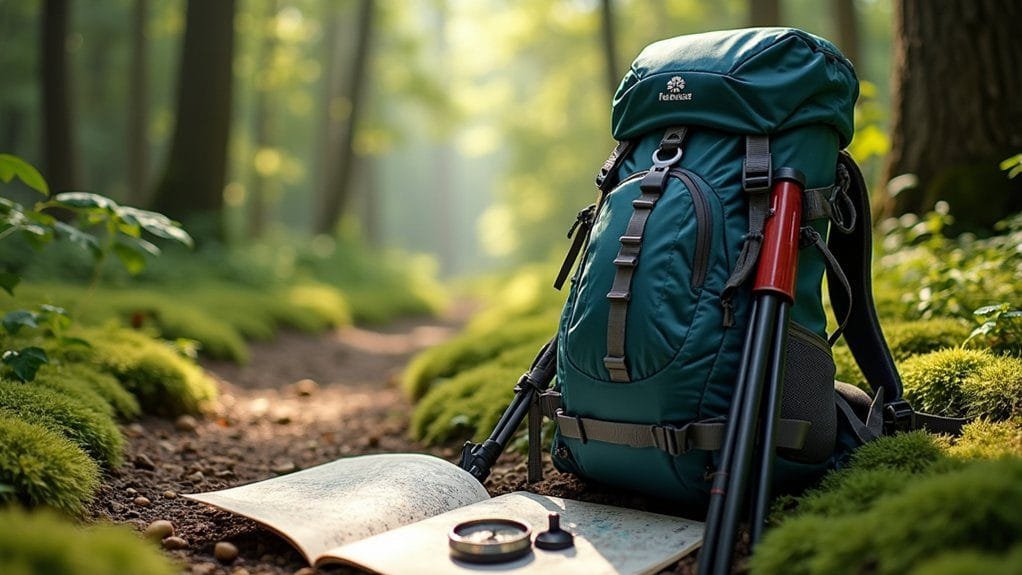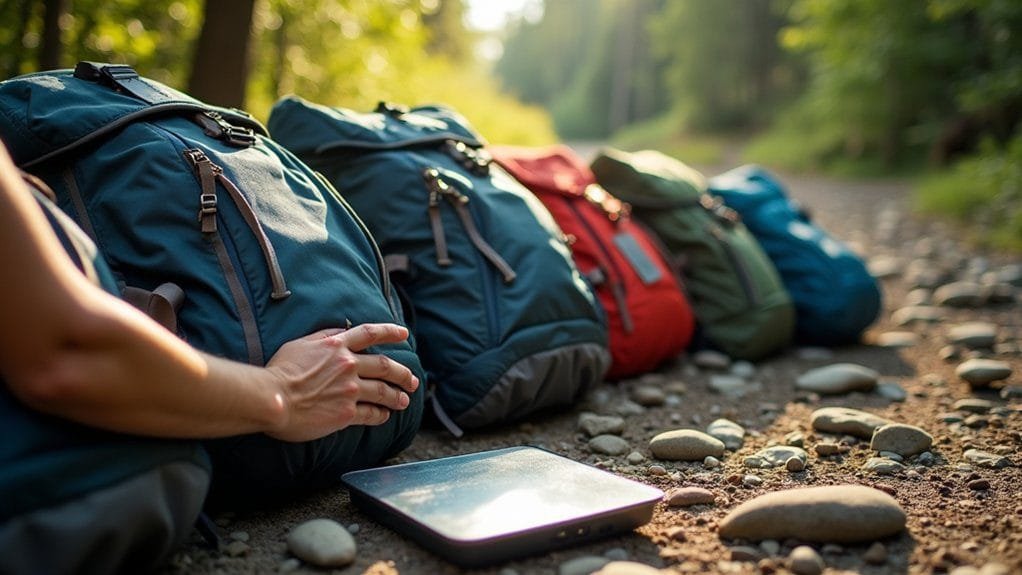When choosing a hiking backpack for long treks, focus on capacity, fit, and weight distribution. Opt for a pack with 70 liters or more to carry essentials comfortably. Make sure it fits well by measuring your torso and hips, ensuring the weight rests on your hips. Look for features like a breathable back panel, adjustable harness, and pockets for easy access. Evaluating materials and durability is essential too. Discover more tips to find your perfect backpack!
Key Takeaways
- Select a pack with a capacity of 70 liters or more to accommodate gear for extended trips.
- Ensure the pack fits your torso length and hip circumference for optimal comfort and weight distribution.
- Prioritize lightweight materials while maintaining durability to manage overall pack weight effectively.
- Look for features such as a suspended mesh back panel and adjustable harness for enhanced breathability and fit.
- Include essential accessories like a rain cover to protect your gear from changing weather conditions.
Understanding Your Hiking Needs


When planning your next hiking adventure, how well do you understand your specific needs? Evaluating your trip’s duration is essential; for 1-3 day hikes, a pack size of 40-56 liters usually suffices, while longer treks may require over 70 liters to accommodate additional gear. Your personal preference plays a significant role, too—do you value comfort, or is lightweight your priority? The terrain and climate you’ll face also dictate your gear requirements, influencing both pack weight and features. Make sure your chosen backpack can comfortably fit essentials like sleeping bags and cooking equipment. For longer treks, self-reliance is fundamental, so select a pack that balances size and weight without sacrificing safety and accessibility. Your hiking experience depends on it!
Determining Pack Capacity
Selecting the right pack capacity is key to ensuring a comfortable and efficient hiking experience. For hikes under 5 hours, a pack volume of around 20 liters or less should suffice for essential items. If you’re heading out for a full day, choose a pack with a capacity of 20-39 liters to accommodate food, water, and extra gear. For 1-3 day trips, look for packs ranging from 40-56 liters to fit your gear, food, and shelter. Weekend excursions typically require packs between 50-75 liters, allowing you to carry up to 40 pounds. For longer adventures or multi-week trips, opt for larger packs of 75 liters or more, designed to hold 50-60 pounds of equipment and provisions.
Evaluating Pack Weight


Evaluating pack weight is essential for a successful hiking experience, especially on long treks. Aim for a total weight around 30 pounds, including water and food, for maximum comfort. Remember, the maximum pack weight should generally be 35-40% of your body weight, while experienced hikers might go up to 50%. A pack that fits well can greatly improve your comfort level by ensuring proper weight distribution. Ideally, 75-80% of the load should rest on your hips, supported by the hip belt. Regularly assess your gear to eliminate unnecessary items and lighten your load. By optimizing your pack weight, you’ll enhance your overall hiking experience and make those long treks much more enjoyable.
Ensuring Proper Fit and Sizing
After optimizing your pack weight, the next step is ensuring your backpack fits you properly. Start by measuring your torso length from the C7 vertebra to the iliac crest, as this helps match the pack size to your body. Most packs come in fixed sizes or adjustable systems, so choose one that suits your torso length and hip circumference. Remember, the hip belt should carry 75-80% of the pack’s weight, so measure your hip circumference at the top of your hip crests for comfort. When trying on a pack, load it with gear or weights and wear it for a while to see how well it distributes the load. Adjust the shoulder straps and hip belt for a balanced fit.
Key Features to Consider


When you’re gearing up for long treks, considering key features in a hiking backpack can make all the difference in your comfort and performance on the trail. Here are some important factors to keep in mind to guarantee you can comfortably carry your gear:
- Suspended mesh back panel: Enhances breathability and reduces moisture buildup.
- Adjustable torso harness: Customizes the fit for even weight distribution.
- Load-adjuster and sternum straps: Improve stability while traversing rugged terrain.
Additionally, look for packs with stretchy mesh side pockets for easy access to water bottles and hip belt pockets for snacks. A rain cover is essential for protecting your gear from unexpected weather. By focusing on these features, you’ll be better prepared for your adventures.
Testing for Comfort and Adjustability
How do you guarantee your hiking backpack is truly comfortable for those long treks? Start by loading your pack with personal gear or retailer-provided weights and wear it for an extended period. This testing for comfort and adjustability is essential. Aim for a weight distribution of 60-80% on your hips, with shoulders and chest supporting the rest. Explore adjustment points, like load lifters and sternum straps, to enhance balance and comfort. Achieving a proper fit is critical; make sure the pack accommodates your torso length, as incorrect sizing can lead to discomfort. Take the time to adjust the hip belt and shoulder straps to create a custom fit that supports your body and improves stability during those long hikes.
Comparing Pack Types
Choosing the right pack type can greatly influence your hiking experience, especially on long treks. Understanding the various pack types helps you select the best one for your needs:
- Day hiking packs: Ideal for short trips, these range from 18 to 45 liters, with 25-30 liters perfect for full-day excursions.
- Internal-frame packs: Designed for multi-day trips, they start at 45 liters and offer better support for heavier loads, ensuring comfort on longer hikes.
- Ultralight packs: Catering to minimalists, these 40-50 liter packs emphasize essential gear, making them suitable for lightweight trekking.
Assessing Durability and Materials
Durability is an essential factor in selecting a hiking backpack for long treks, as it directly impacts your comfort and safety on the trail. Prioritize backpacks made from high-denier nylon or polyester fabrics, which resist wear and tear better than lower-denier materials. Look for reinforced stitching and zippers that can withstand the rigors of heavy loads. Additionally, water-resistant features, like coated fabrics or integrated rain covers, are imperative for protecting your gear from inclement weather. Research established outdoor brands known for durability; they often back their products with warranties and reliable customer support. Finally, regularly check straps, seams, and buckles for wear and tear, as these components are essential to your pack’s overall durability and functionality.
Budgeting for Your Backpack
When planning your hiking adventures, it’s essential to establish a budget for your backpack that aligns with your financial situation. Prices typically range from $50 to over $300, so consider the long-term value of quality and durability. Investing in a well-constructed pack can save you money on replacements down the line.
Establish a budget for your backpack, considering quality and durability for long-term value in your hiking adventures.
Here are a few budgeting tips:
- Look for clearance sales or second-hand options to score high-quality packs at reduced prices.
- Factor in additional costs like rain covers or hydration reservoirs in your budget.
- Assess features that match your hiking style to guarantee the investment is worthwhile.
Frequently Asked Questions
What Size Backpack Is Best for Long Distance Hiking?
For long-distance hiking, choose a backpack between 50-70 liters. Make certain it fits your torso and hips, supports backpack weight effectively, and includes essential features like side pockets for easy access to gear during your trek.
Do I Need a 40L or 50L Backpack?
Imagine a feather-light breeze guiding your steps; you’ll want a 40L for short adventures or a 50L for comfort on longer treks. Prioritize packing strategies and comfort features to keep your backpack weight manageable.
Is a 70L Backpack Too Big?
A 70L backpack isn’t too big if you need extra gear capacity. Just guarantee you’re mindful of backpack weight, focus on pack organization, and prioritize comfort features to enhance your trekking experience.
Is a 40L Backpack Too Big for a Day Hike?
A 40L backpack isn’t too big for a day hike if you need extra room for day hike essentials. Just guarantee it has comfort features and manageable backpack weight to keep your adventure enjoyable and efficient.
Conclusion
Choosing the right hiking backpack can make all the difference on your long treks. Did you know that a well-fitted backpack can reduce fatigue by up to 30%? By understanding your needs, evaluating capacity, and ensuring comfort, you can enhance your hiking experience. Remember to take into account durability and budget as you shop around. With the right backpack, you’ll be ready to tackle any trail and enjoy the great outdoors to the fullest! Happy hiking!
